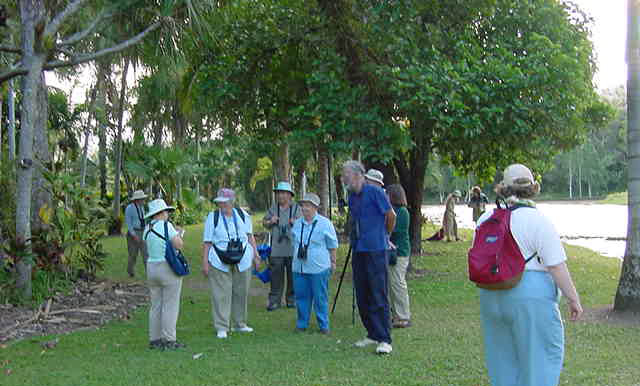|
by Ned C. Hill
(text & photos)
&
Milt Moody (web adaptation)
(Originally published as a series in the Utah County
Birders Newsletters in 2002)
|
|
|
1. Cairns |
2. Carns & Atherton Tablelands |
3.Mareeba Kingfisher Park &
the Diantree River |
| 4. Binna Burra Lodge &
Lammington NP | 5. Iluka & Oakhampton |
6. Kiama & the South Coast | |
|
|
|
|
Part 1: Cairns
Planning the Trip
In February 2000, my wife Claralyn and I
were invited to go to Sydney, Australia, in connection with my
assignment at Brigham Young University. When our very gracious
host (Jonathon Fisher, a BYU graduate) asked us what he could
do to make our stay more pleasant, without hesitation I told
him we would like to do a bit of birding. After a few phone
calls-the first to a zoo where he was told we probably didn’t
want that kind of birding experience-he found a bird tour
guide, Richard Jordan of Emu Tours. We ended up spending three
full days with Richard in and around the vicinity of his home
in Jamberoo, a couple of hours drive south of Sydney. We were
able to see nearly a hundred Australian birds during those
three days and we were completely hooked on the country, its
people and its wildlife. Richard proved such a wonderful guide
that we asked him to propose a tour we could share with Utah
County Birders. When we suggested it to our UCB friends, many
seemed interested in exploring Australia, too. After trying
out various dates and itineraries, we finally settled on
August to allow the maximum number of our friends to attend
and to accommodate Richard’s busy tour schedule.
BYU’s Kerri Strout helped us find a great price on tickets
through a consolidator. In July, we hosted a picnic at our
home for all participants so we could talk about what to bring
and how to prepare. We even learned the meaning of the words
to “Waltzing Matilda” and listened to a few of the bird sounds
we might encounter. We also pondered the fact that virtually
all snakes in Australia are poisonous and that many of the
spiders in the country are deadly. Australia also hosts the
most toxic animal on earth-the box jellyfish. Hmmmm. In spite
of these interesting bits of information, 15 brave souls had
signed up by the time the tour began on August 8th.
The first leg of a trip to Australia is not too bad-just Salt
Lake to San Francisco. But the next leg is one of the longest
non-stop flights in the world: 15 hours from San Francisco to
Sydney. Not only that, when you cross the International Date
Line somewhere in the Pacific, you lose a whole day. Having
had some business in Sydney beforehand, I had arrived two days
earlier and met the group the morning of the 10th at the
airport. They were easy to find-all of them had their
binoculars up intently studying the grassy area between the
runways looking for their first Australian birds: some Common
Mynas and a few distant Cattle Egret. Some of the group
reported they had enjoyed 8 hours of sleep on the way over.
All were present and accounted for: Ivan Call, Milton Moody,
Bert and Sylvia Cundick, Donna and Mary Anne Thorum (from Salt
Lake), Ed and Beula Hinckley, Alton and Ardith Thygerson,
Flora Duncan, Leila Ogden, Junece Markham and Carol Nelson. We
boarded a flight to Cairns (pronounced “cans”) in the
northeast part of the country, about a 2 hour flight.
Cairns
|
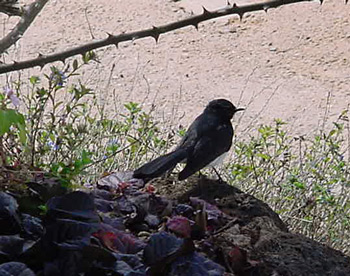
Willie-wagtail |
Richard Jordan and his assistant Rozlyn met us with the
soon-to-become-very-familiar brown Emu Tours bus-a 20
passenger Mercedes with a luggage trailer attached to the
rear. All our luggage arrived safely and, as we exited the
terminal, a Brown Honeyeater was noisily waiting for us in a
flowering bush-one of the many species of honeyeater we would
find in Australia. A Willie-wagtail walked around wagging his
tail (how’d he get that name?) in the grass near the bus. The
terrain around Cairns is much more mountainous than we had
expected. It was very green and warm-realize that Cairns is as
far south of the equator as Guatemala is north. The city is on
the coast and has become quite popular as the place from which
to visit the Great Barrier Reef and a favorite spot for
backpackers on long vacations.
Before taking us to our hotel, Richard drove us through a
cemetery. That seemed a little odd at first until we spotted
the target bird he wanted us to see, a Bush Stone-Curlew (or
Thick-knee), a large, rare shorebird only found in a few
reliable places around here. We were to be quite impressed on
this occasion and many more with the distinct advantages of a
local guide who knows the area well! We also found Yellow
Honeyeater, Brown-backed Honeyeater, and the very colorful
Rainbow Bee-eater and Forest Kingfisher.
Our hotel was a mid-range one called “Inn the Pink, Hotel in
the Round.” It was definitely both pink and round. After a
brief chance to rest and wash up from the long trip, we
boarded the bus and went to the nearby Centenary Lakes Park
for birding and a picnic lunch. Lunch was always pretty much
the same routine: Richard and Roz would prepare fixings for
sandwiches and lay out canned vegetables, citrus drink, peanut
butter, cheese, etc. They were always worried about providing
herb teas for us but no one in the group had developed much of
a tea habit. Richard is British and liked to set out a proper
meal complete with tea. While they prepared lunch, we explored
the park and located a Spangled Drongo that liked to fly down
to the pond to catch insects. Richard joined us and showed us
both Yellow (Green) Oriole and Olive-backed Oriole. High in
the trees, we found Helmeted Friarbird, Varied Triller,
White-throated Honeyeater and the improbably beautiful but
common Rainbow Lorikeet. Our necks began to stiffen into a
permanent upward tilt. Of course, we saw-as we did every day
of the trip-Australia’s national bird, the Laughing
Kookaburra. Many times we heard its uproarious laugh to cheer
us on our way. But we did wonder, “What’s so funny?”
|
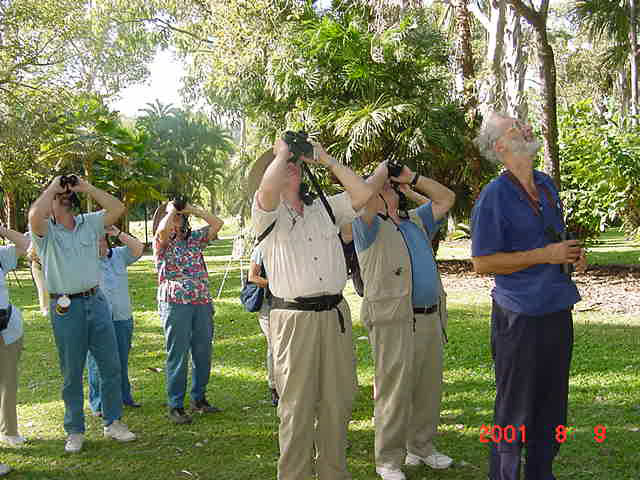
"Our necks began to stiffen into a permanent upward tilt" |
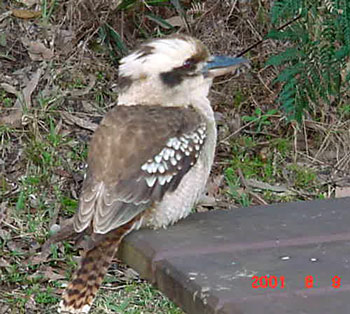
Laughing Kookaburra |
A Brahminy Kite soared over the trees and White-breasted Woodswallows,
Welcome Swallows, Pied Currawongs and Common
Mynas were on the poles and wires. The ponds held Pacific
Black Duck, Dusky Moorhen, and Australian White Ibis. As we
walked back to lunch in a picnic shelter, two Orange-footed Scrubfowl were walking along scratching at the undergrowth. We
later learned that these unusual birds build huge mounds up to
fifteen feet high in which to place their eggs. A large sign
by the river near our lunch read: “Danger: Estuarian
Crocodiles Inhabit the River.” None of us went swimming.
|
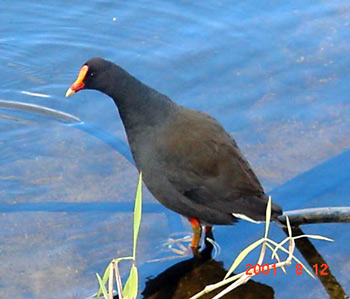
Dusky Moorhen |
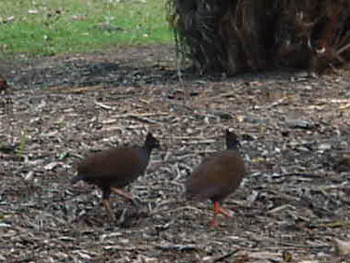
Orange-footed Scrubfowl |
We drove over to the Esplanade or water-front near our hotel.
The tide was out and we saw Far Eastern Curlew, Whimbrel,
Great Knot, Curlew Sandpiper, Great-crested Tern, Caspian Tern
and the beautiful and ever-present Silver Gull with bright red
feet and bill. We capped the day with a delicious barramundi
(fish) dinner at Willey McBride’s. Everyone slept unusually
soundly that night.
|
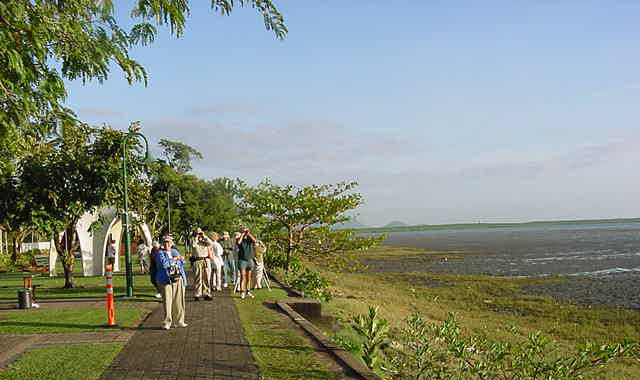
On the Esplanade |
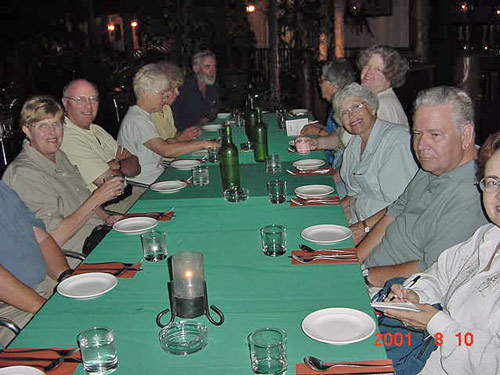
Dinner at Willey McBride’s |
Great Barrier Reef
|
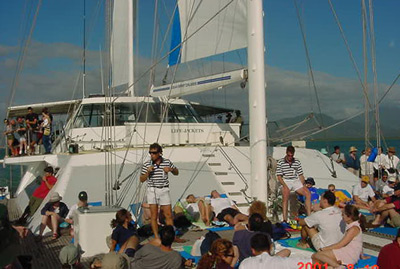
90-foot catamaran |
|
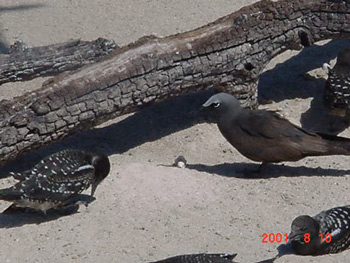
Common Noddy with Sooty Terns |
The Great Barrier Reef is 2/3’s the size of the entire state
of California. It is one of the largest reefs in the world and
the home to a huge diversity of sea life. It is also one of
Australia’s most popular tourist attractions. We arose early,
had a light breakfast in our rooms and then got on a bus for
the Pier-a huge waterfront shopping center and jumping off
point for reef tours. Richard did not join us for this
day-he’s been on that trip on many occasions and he said he
gets seasick. In addition, there are not likely to be too many
pelagic birds to identify. Our vessel was a 90-foot catamaran
powered by its own engines or sails. It held about 150 people
and was close to capacity. We went out about 20 miles (2
hours) to Michaelmas Cay, a very small sandy island surrounded
by parts of the reef. The sea was fairly calm but a few in our
group were feeling a bit woozy by the time we arrived. We were
amazed by the lack of bird life en route to the island. We
managed to see a few Brown Boobies perched on buoys but no
shearwaters, petrels, etc. Richard told us later that pelagic
bird life is much better further south in colder waters. On
the Cay, we saw clouds of Common Noddies and Sooty Terns. They
nest on the island. Bridled Terns evidently come in later-we
saw none. We also saw a Greater Frigatebird and tried vainly
to make it into a Lesser (since many of us had seen the
Greater in Hawaii).
From the catamaran, we boarded a semi-submersible craft that
held about 20 people. This permitted a wonderful underwater
view of the reef. We circled the island and saw a rich variety
of coral, fish and other sea life. I was surprised that the
colors seemed mostly brownish-I had expected a wider range.
|
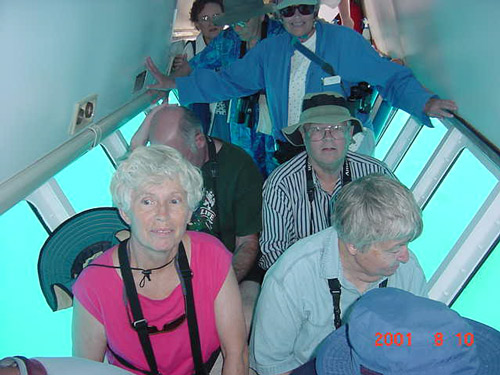
In the semi-submersible |
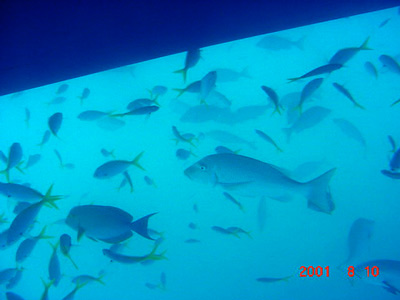
View from the semi-submersible |
After a sumptuous onboard buffet luncheon, we took the small
launch or “Beach Buggy” ashore. We could get very close to the
roosting/nesting terns and noddies. We studied the Common
Noddies carefully looking for a Black Noddy. We finally found
a likely candidate but they are so difficult to tell apart.
This one had a thinner bill and seemed a shade blacker. There
were many Crested Terns and Silver Gulls around, too. Our
guide took us in the Beach Buggy around the island to see if
there were any other kinds of birds. We found one Black-naped
Tern. That excursion around the cay cost us the time we would
have spend snorkeling so I missed one of my objectives of the
trip. Milton Moody did manage to quickly change and get in the
water to snorkel for a few minutes. On the trip back to
Cairns, the wind picked up forcing most of us inside. As we
came into the harbor, a juvenile Australian Darter was perched
on the seawall. After a great Italian dinner at Al Capone’s,
we all went to bed exhausted from our long day.
Next: We search for the prehistoric-looking Cassowary.
|
|
|
|
|
1. Cairns |
2. Carns & Atherton Tablelands |
3.Mareeba Kingfisher Park &
the Diantree River |
| 4. Binna Burra Lodge &
Lammington NP | 5. Iluka & Oakhampton |
6. Kiama & the South Coast | |
|
|
|
|
|
Part 2: Cairns
& Atherton Tablelands
This is the second part of the birding adventure 15 Utah
County Birders experienced in eastern Australia during two
weeks of August, 2001.
The Cassowary Hunt
|
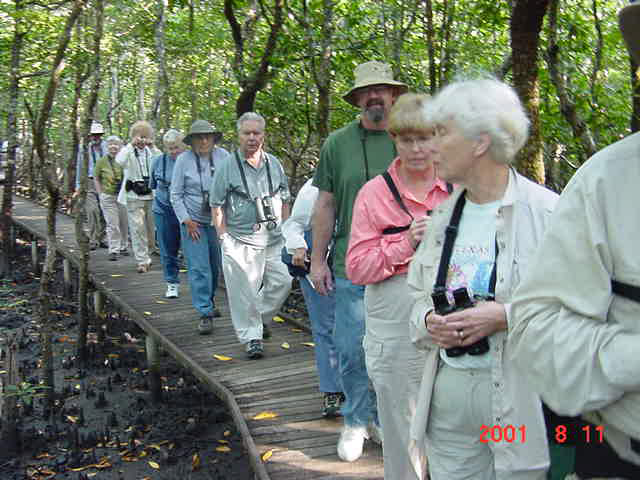
Boardwalk through a mangrove swamp |
We arose early in our hotel in Cairns.
We were at the esplanade (coastal walkway) at first light
scoping the mudflats when our guide Richard became very
excited. A Beach Stone-Curlew (Thick-knee), quite a rare bird,
was standing just off the walkway. He hadn’t seen one for some
time. A thick-knee is a large, heavy shorebird. We also added
Great Egret (yes,
the same species we have in the U.S.), Striated Heron,
Red-capped Plover, Red-necked Stint, and Common Greenshank to
our list. In the trees we found the colorful Green Figbird and
Varied Honeyeater. Near the Cairns airport is a boardwalk
through a mangrove swamp. We walked it and saw a beautiful Mistletoebird — a brilliant black and red bird that is
responsible for distributing the seeds of mistletoes
throughout Australian forests. We also found a
Yellow-bellied (Olive-backed) Sunbird, many Brown Honeyeaters, a
Sacred
Kingfisher and heard but could not see Mangrove Robin. After a
buffet breakfast at McBride’s, we went to Centenary Lakes
again and found a nice picnic area in which to hold a short
Church service. It was a peaceful setting with the voices of
birds all around us. The only new bird we added was a Black
Butcherbird with a distinctive call.
Everyone wants to see a Southern Cassowary when they are in
northern Australia. This unusually large, prehistoric looking
bird is becoming quite rare. In previous years, Richard could
almost guarantee a Cassowary at one of our later stops but
that individual died recently — victim of a hit-and-run. That
left Mission Beach as the only possibility for finding a
Cassowary anywhere near our tour route. So, we all agreed to
change our plans and head south about 70 miles.
Underway we saw fields filled with sugar cane and passed
several mountains rising to about 3,000 ft. As we approached
our destination, we encountered road signs warning motorists
to watch out for Cassowaries crossing the road. We had lunch
at an area designated “Cassowary Protection Area.” Above our
heads we heard and then saw the very unusual Wompoo Fruit
Dove. Its call sounds like a little old man in a puppet show
and its colors are green and pink. A walk through the rain
forest produced some great birds: Pied Monarch, a striking and
rare find, Spectacled Monarch, Little Shrike Thrush, and
Eastern Yellow Robin. We fanned out to look for the Cassowary
with the instruction that anyone finding it would holler,
“Coo-ee, coo-ee!” That is an old Australian signal I once read
about in a Sherlock Holmes adventure. Several of us went
across the road to look and we met a couple coming up the
trail who said they had seen a pair of cassowaries a few
minutes ago. We hadn’t walked far down the track when we heard
the call from Richard, “Coo-ee!” We began racing back to the
road where we found Richard reporting that someone had just
seen the birds walking in the stream. We ran at varying speeds
depending on physical shape until we met up with Roz and
others——but no Cassowaries. They had sauntered up the stream
and disappeared.
We drove to another cassowary protection area a few miles
away. A determined walk through tracks in the area produced
some warm cassowary dung but not the bird that left it! We did
see a Spotted Catbird and heard its haunting catlike call.
While several doves had to be listed as “heard only” that day,
our Cassowary had to go down as “dung only.” It was dark when
we
returned to our hotel. Birding is full of surprises: both the
positive and negative kinds.
Atherton Tablelands
|
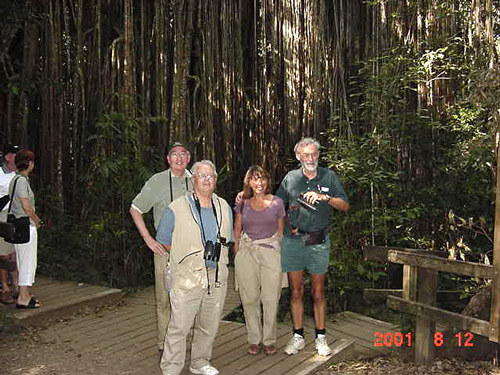
Atherton Tablelands |
Ivan and I arose at 6:00 a.m. the next morning to get one last
walk to the esplanade to look for shorebirds. In the beautiful
sunrise, we found a colorful little shorebird, a Black-fronted
Dotterel and a Caspian Tern. The others chided us for finding
a new bird without them — but we found the dotterel a day or
so later for all to see. We loaded up the trailer and headed
up into the Atherton Tablelands above Cairns — a well-known
area for birds. This was one of our very best days for adding
new birds. The road rises steeply into the mountains. At one
turnout, Richard stopped the bus and quickly heard the call of
a Scarlet Honeyeater (Myzomela) in the trees. Everyone got a
good look but me! Then a Fan-tailed Cuckoo perched on a low
limb.
|
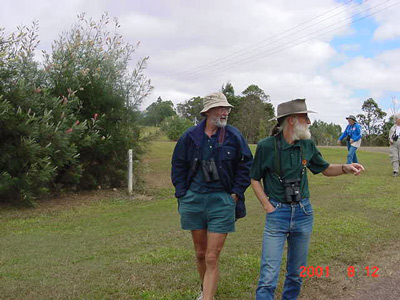
Richard with local guide Glenn Holmes
|
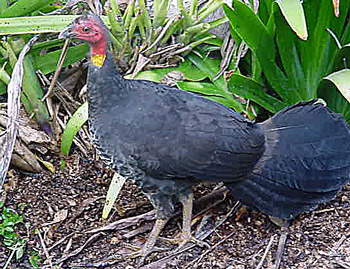
Australian Brush-turkey
|
|
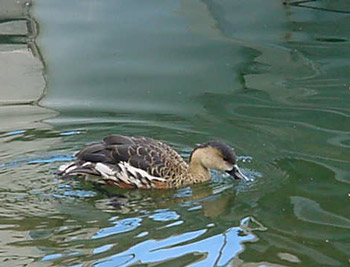
Wandering Whistling Duck |
At Lake Barrine Australian Brush-turkeys awaited us in the
parking lot as we climbed off the bus. These birds have bright
red heads and bright yellow wattles and were quite tame in
most of the areas we visited. Here we met our local guide
Glenn Holmes, a true “Crocodile Dundee” type of fellow with a
gray beard and ponytail who knows the woods and the birds
better than he knows his own house. He quickly showed us a Wandering Whistling Duck,
Lewin’s Honeyeater, and Large-billed Scrubwren. On the lake were
Black Swans, Hardheads (White-eyed
Ducks), Little-pied and Black Cormorants. A nice little
tourist shop tempted many in our group to part with some of
their spending money. Above the shop, several of us found
Dusky
Honeyeater (Myzomela) and White-throated Treecreeper.
Glenn had Richard drive our bus to a hedge near an open field.
In the hedge we found an unbelievable variety of Honeyeaters
(Scarlet, Dusky, Yellow-faced, White-throated, White-cheeked).
Richard, Roz and Glenn were so patient with us, making sure
everyone got a chance to see each bird whenever possible. An
Australian Hobby flew overhead — I dashed out of the bus to
get a better look but by then it was gone. Sarus Cranes flew
overhead and a Spotted Harrier did some acrobatics for us.
Around the shores of Lake Tinaroo we found Comb-crested Jacana
— with very long toes for lily pad walking — and two tiny
geese: Cotton Pygmy-Goose and Green Pygmy-Goose. The rest of
the group also got to see the Black-fronted Dotterel missed
earlier along with a flock of striking Plumed Whistling Ducks.
A small group of Scaly-breasted Lorikeets (or as Richard says,
“Sky-lee”) were in a tree and we found our first of many
Whistling Kites.
|
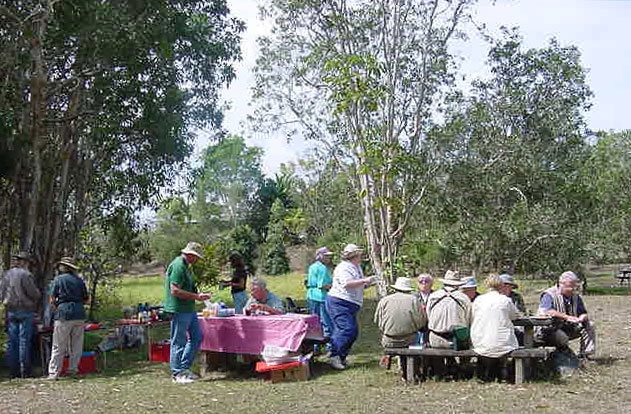
The name "Atherton Tablelands" turned out to mean
something we didn't expect. |
Stopping for lunch in a forested picnic area Glenn said he
heard the distant call of a Riflebird — one of those very
unusual Australian birds that sometimes poses proudly with
head thrown back and wings drawn into a circle. We all hoped
it would come near and Glenn built up our expectations by
saying it often used a perch close to where we were eating.
One species
of Riflebird up in New Guinea actually sounds like a rifle, he
told us — but this one sounded more like a metallic rasp. The
sound got nearer. After lunch we all walked to a grassy area
and began scanning all possible open perches — the sound was
very close. Suddenly Glenn pointed out a black-looking bird
perched on an open limb not too far from us. We all got a
great look at a feeding male Victoria’s Riflebird with its
subtle green and purple colors. A female came into view, too.
Then we heard the unusual call of the Eastern Whipbird
—“wheeeeeee-rip, chunk, chunk.” The first part of the call is
the male and the answering “chunk chunk” is provided by the
female. Generally they are very difficult to see since they
remain in the thick undergrowth. But to our surprise, one bird
walked right out on to the grass then got up on the picnic
table! Richard and Glenn were amazed. From that grassy area
surrounded by tall eucalypts we also saw Bridled Honeyeater, MacLeay’s Honeyeater, Rufous Whistler, and
Rufous Fantail.
We checked into a little motel with lots of personality in
Yungaburra, a small town on the Tablelands. Before dinner,
Glenn took us on a walk down to a gently moving stream. In the
fading light we saw a dark blue bird streak up then down the
stream — an Azure Kingfisher. As we lined up along the stream
very quietly to watch the water’s surface, a white-phase Gray
Goshawk flew by — evidently, from Glenn’s excitement, a rare
find up here. We soon saw what we were looking for — the water
started to ripple and a strange looking bill attached to a
small head, dark body and flat, beaver-like tail
came to the surface and rolled back down below. It repeated
this three times: a Duck-billed Platypus! It was only about
two feet long and didn’t stay around very long. One of only
two species of egg-laying mammals, this monotreme is nocturnal
and lives in dens in the river banks. It uses underwater
openings to the dens so it is seldom seen during the day. At
dusk, this stream is one of the places one can reliably find
the platypus.
We returned to a wonderful dinner made by the people who own
the motel — we were their only guests. After dinner, we went
through our nightly ritual of reviewing all the birds we had
seen that day — about sixty species! I also reported on some
of rare birds I had encountered but that were generally missed
by the group: Black-faced Cookie Strike, White-centered Oreo,
Victoria’s Secret Riflebird, French Friarbird, Peanut Butter
and Honeyeater, Wampoo Fruit Bar, Strangled Drongo, Stoned
Curlew, Scrawny-necked Ibis and the Duck-billed Platitude.
|
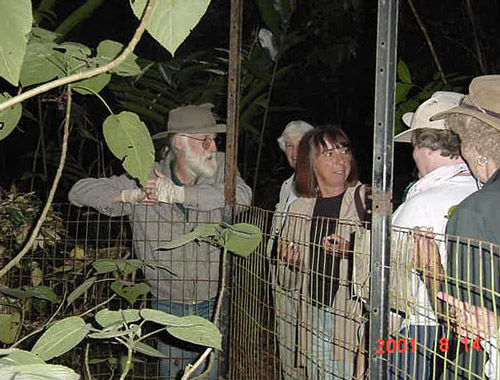
Protective fence around a poisonous plant |
We tried “spotlighting” after dinner — where you drive around
in the bus using a powerful spotlight to illuminate the trees
in search of eyes looking back at you. No success except for a
few Brown Bandicoots crossing the road. But the stars!! None
of us had ever seen the Milky Way look as brilliant as it did
out on that dark country road far from city lights.The next
morning, breakfast was brought to our small patios right
outside our rooms. The cacophony of bird sounds was wonderful:
Helmeted Friarbird, Lewin’s, Brown and Scarlet Honeyeater and
Yellow-bellied (Olive-backed) Sunbird. A pair of
Nankeen (Australian) Kestrels were on the roof of a church across from
the hotel and Bar-shouldered Doves perched on wires.
|
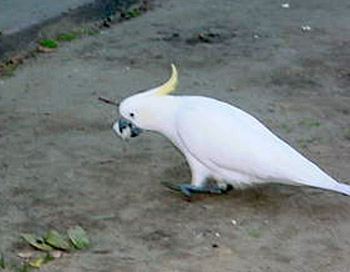
Sulphur-crested Cockatoo |
We packed up the bus and drove to the larger town of Atherton
to pick up Glenn at his home. In his little yard he reported
seeing some 220 species! He took us to a street where we could
get good looks at Eastern Spinebill (another honeyeater) and
White-faced Honeyeater. Then out into the country where he
showed us the nest of a White-bellied Sea Eagle with the bird
soaring nearby — far away from the sea. In the distance, we
saw a huge flock of black birds — on closer inspection they
were hundreds of migrating Red-tailed Black Cockatoos. As they
spread their tails before landing in a tree, we could pick out
the brilliant red on the tails. Over an open stubble field we
flushed four Australian Bustards into lumbering flight. These
are Australia’s heaviest flying birds. In that same field was
a flock of the common Sulphur-crested Cockatoos and overhead
was a circling Wedge-tailed Eagle. Suddenly the eagle plunged
into the cockatoo flock and grabbed one of the birds. It flew
up to a low limb and proceeded to devour its catch — something
Glenn and Richard had not seen — and, of course, we hadn’t
either.
Next — we find a bird even Richard has never seen.
|
|
|
|
1. Cairns |
2. Carns & Atherton Tablelands |
3.Mareeba Kingfisher Park &
the Diantree River |
| 4. Binna Burra Lodge &
Lammington NP | 5. Iluka & Oakhampton |
6. Kiama & the South Coast | |
|
|
|
|
|
|
Part 3:
Mareeba Kingfisher Park & the Daintree River
This is the third part of the birding adventure 15 Utah
County Birders experienced in eastern Australia during two
weeks of August, 2001. In this part we are still in the higher
lands west of Cairns in northeastern Australia.
Mareeba
On a warm, sunny day, we stopped in Mareeba, a moderately
large town in the Atherton Tablelands. Here we saw our first Blue-winged
Kookaburra, the tropical and much less common Kookaburra.
It flashes azure blue patches on its wings. In the middle of
the municipal golf course, we were delighted to see our first
wild kangaroos—a couple of dozen Eastern
Grays. They were leisurely resting under some trees and
let us get quite close. They are fairly tall, perhaps about
five feet. This was evidently a family gathering as there were
some little ones also. Near the kangaroos, we saw a small
flock of Apostlebirds—so named because
they go around in groups of about twelve. A pair of Gray-headed
Babbler was up in a tall tree.
|
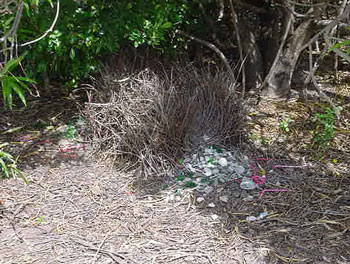
Bower of a Great Bowerbird |
Under that same tree, our guide Glenn showed us the bower
(house) of a Great Bowerbird. These unusual
birds create a display area on the ground by forming a
"runway" lined with tall grass stalks and then decorating it
with any white, silver or yellow things decide to strew on the
ground leading up to the runway: screws, shells, pebbles,
buttons, plastic, feathers, etc. The bower is developed under
a bush and is calculated to be quite an attraction to lady
bowerbirds. A female chooses her mate based in part on how
fancy the bower is. The nest is made elsewhere up in a tree.
Each species of bowerbird—there are eight in Australia—is
attracted to different colors. The Satin Bowerbird common
further south is partial to light blue trinkets. I guess we
humans aren’t the only ones who try to attract mates with
material offerings.
Along the streets of Mareeba we observed many Aborigines—but,
like most of our Native Americans, they appeared to have been
assimilated into the local society, wearing modern clothes and
Michael Jordan basketball shirts. Aborigines arrived in
Australia perhaps as long as 50,000 years ago—no one knows
their origin. They drove off the first explorers in the 1500’s
but could not resist the British who settled in the Sydney
area during the late 1700’s. Their history has paralleled that
of our Native Americans. Aborigines now have seats in
parliament and one even won a gold medal in the recent Sydney
Olympics.
Pausing for a proper British picnic lunch in Mareeba, we found
a tree literally filled with Flying Foxes or fruit
bats. They dangle from branches during the day and then forage
for fruit at night—no, they don’t drink human blood in spite
of their ominous appearance. We also got a look at a Pacific
Baza (a raptor) flying over the picnic area and finally
saw several Great Bowerbirds. Before
leaving Mareeba we found one of our favorite birds of the
trip, Pale-headed Rosella with a lovely
blend of yellow, blue and white with a touch of bright red
under-tail coverts. Driving along the highway, we stopped at
Lake Mitchell where we found Glossy Ibis (same
species as in the eastern U.S.), the striking Magpie
Goose and Yellow-billed Spoonbill. At
the Abbotour Swamp we walked along a boardwalk to a blind.
There was not much out on the water, but we found a Northern
Fantail in the trees. Then Richard spotted a Gould’s
Bronze Cuckoo and a Lemon-bellied
Flycatcher for us. Most of us got good looks at the
colorful and melodious Rufous Whistler.
Kingfisher Park
|
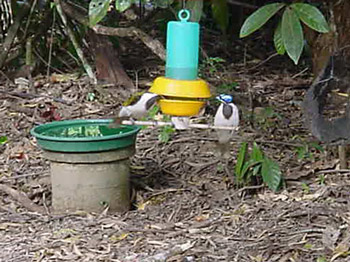 |
|
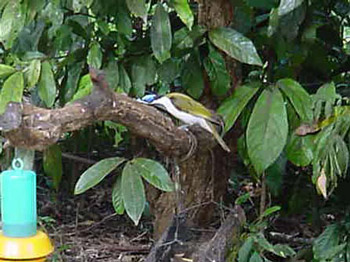
Blue-faced Honeyeater (in photo above, too). |
|
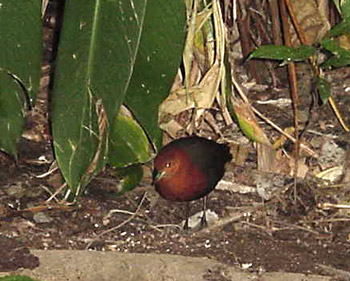
Red-necked Crake |
|
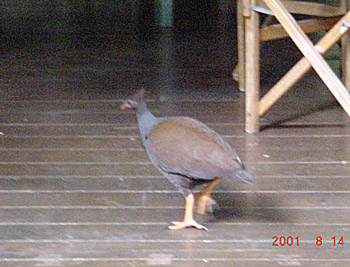
Orange-footed Scrubfowl jointed us for dinner |
Late in the afternoon our Emu Tours bus carried us to one of
the most memorable stops of the trip: Kingfisher Park, a lodge
catering almost exclusively to birders. The owners have
maintained several acres of rainforest and also set out
various kinds of feeders that attract birds. Before even
checking into our rooms, we found the large and beautifully
colored Blue-faced Honeyeater frequenting one of the
feeders. We just sat sipping lemonade at a table in the
shade and watching the display. Graceful
Honeyeaters were also plentiful. The owner called us over
to see check out a drip tube where he had scattered seeds and
small bits of cheese. It was near some dense shrubs. Tiny Red-browed
Finches came in flocks, but the real treat—the rarity of
the entire trip—was a Red-necked Crake. This
secretive rail is almost never seen as it inhabits thick
marshes. Our guide, Richard, who has seen virtually every bird
in Australia, had never seen this bird until that afternoon.
As we watched—almost not breathing—the crake cautiously walked
into view and carefully pecked at the cheese bits allowing us
to get a picture. An Emerald Dove was
perched in our outdoor dining room. Glenn led a walk around
the rainforest grounds where we found another great bird: Noisy
Pitta. This bird of improbable colors (green, yellow, red,
brown, black, blue, and white) was walking in the grass like a
robin and gave us great looks. Glenn also showed us a Metallic
Starling nest surrounded by several birds that had just
returned on migration. In an old, overgrown orchard on the
property, Milton found a star-fruit tree and had us all sample
its sweet citrus taste. At dinner an Agile
Wallaby (a small-sized kangaroo) scampered around under
our tables begging for food.
After dinner most of the group was ready to call it a day. But
a few hardy souls joined Richard and Glenn for some
spotlighting and owling just a short distance from the lodge.
Our main target was perhaps one of the rarest owls in
Australia—if not the world—the Lesser Sooty Owl. This
owl is related to the Barn Owl and is one of the only owls
Phoebe Snitzinger (who saw over 8,000 birds in her lifetime!)
did not see—although she visited Kingfisher Park for five
days. Richard is fundamentally opposed to using tapes; but,
thankfully, he is not opposed to whistling. So Richard and
Glenn stood under some very tall trees next to a playing field
and whistled a perfect Lesser Sooty Owl call. They tried for
several minutes and we finally heard a reply in the form of
very strange hissing, electronic sounds penetrating the
darkness. More whistling. More strange sounds from the trees.
Glenn shined his flashlight up through the trees and finally
located the owl very high in the treetop. We all got a great
look but could not get it to come any closer. What a great
find! Glenn and Richard are magicians. For most of us, this
day provided the highest life list total of the trip. Before
departing for our rooms we bade farewell to Glenn, truly an
amazing man with a sixth sense for birds.
Daintree River
We left Kingfisher Park very early for the drive down to a
much lower elevation north of Cairns. As we approached the
Daintree River the night sky was just beginning to lighten. In
the twilight, we saw dozens of Spectacled Flying Foxes heading
for their daytime roosts. Casting lots, half of the group went
on the early river cruise with Chris Dahlberg while the other
half went with Richard to look for Lovely Fairy-Wren and other
birds. We failed to do more than hear its call but we did find Osprey (yes,
the same species we have in Utah), Little Friarbird,
Mistletoebird, Fairy Gerygone, Spectacled Monarch and Yellow
(Green) Oriole. After a hearty English breakfast—with a
month’s supply of tasty cholesterol—we greeted the returning,
early group and learned they had been successful in finding a
rare Little Kingfisher. The wind picked up
as the second group started the cruise. Chris is an engaging,
energetic guide and able pilot of our 20-foot river craft. We
left the roughness of the main river and went off into a calm
tributary and were very excited to find above our heads a Papuan
Frogmouth (an owl-like bird) sleeping on a limb looking
very much like part of the tree. We also found Shining
Flycatcher, plenty of Azure Kingfishers and
a pair of Pacific Baza—but we failed to
find the Little Kingfisher. As we passed under a fat tree
limb, Alton spotted a large python curled around a large knot
right above us—it was not there when we returned a few minutes
later (that’s a bit disconcerting). We found Water Dragons and
even a small crocodile along the shore. The river was most
picturesque and relaxing. We were sorry to have to return to
the dock—especially after missing the kingfisher and our only
shot at Great-billed Heron. Near the dock, another boat
signaled to Chris where to find a large crocodile. We changed
course and got to see a 12-foot Estuarian Crocodile sunning
itself on the shore. Word has it that they are very fast when
they want to be. We did not test that theory.
We drove back to Cairns and tried birding at Centenary Park
but the wind was strong and the birds few. Richard took some
of us over to the mangrove walk near the airport. We whistled
the simple call of the Mangrove Robin and finally heard
a response. We kept whistling and the call would seem to come
closer then back off. Finally, a few of us got to see the bird
before it flew back deeply into the mangroves. What an elusive
little fellow!
We returned to our hotel "Inn the Pink" and turned in earlier
than usual. We were all a bit exhausted from the long and
exciting days we’ve had lately. Tomorrow would come early as
we have an early morning flight for Brisbane. Poor Roz was
tasked to drive the bus down the coast the necessary 1000 km
but the rest of us got to fly. She would catch up with us in a
day or so.
Next: Part 4, The Brisbane Area and Lammington National Park
|
|
|
|
1. Cairns |
2. Carns & Atherton Tablelands |
3.Mareeba Kingfisher Park &
the Diantree River |
| 4. Binna Burra Lodge &
Lammington NP | 5. Iluka & Oakhampton |
6. Kiama & the South Coast | |
|
|
|
|
Part 4: Binna
Burra Lodge & Lamminton NP
This is the fourth part of the birding adventure 15 Utah
County Birders experienced in eastern Australia during two
weeks of August, 2001. In this part we move south down to the
Brisbane area and visit one of the most famous birding areas
in Australia—Lammington National Park.
Binna Burra Lodge
Up at 4:00 a.m. to prepare for a 6:00
flight to Brisbane. We all fit into a couple of large taxis
for the short ride to the Cairns airport. The plane landed a
bit late because of heavy smoke from some large bush fires
fairly close to Brisbane. These can be quite severe in
Australia. Richard, who had flown down last night, met us with
a bus and took us south and west into the
mountains above the Gold Coast. Lammington National Park is
one of Australia’s top birding hot spots. It is home to many
Australian specialties including the very elusive Regent
Bowerbird. It is a beautiful place to bird with tall trees,
streams, hiking trails and quite a spread in elevation. Our
rooms at the sixty-year-old Binna Burra Lodge—located inside
the park—looked
rustic from the outside but four-star from the inside. The
food was also four-star. No weight loss programs possible
here! From our high vantage point we could see below us
expansive forests stretching to the tall buildings of the Gold
Coast. The blue of the ocean was clearly visible. Egg Rock, a
sharp pinnacle with a boulder on top, rose into the sky from
the slopes below us. Mixed eucalypt/evergreen forest
surrounded us. Bird sounds were everywhere. Birding heaven!
Now that we are out of the tropical areas around Cairns, the
flora and fauna have changed considerably and a whole new set
of birds can be found. As we waited to check in, Noisy Miners
(another in the Honeyeater family) flew around our heads
proving why they’re called “noisy.” A Pied Butcherbird perched
on a railing on the main lodge building. We were surprised
when it disappeared through a door into the building. A
caretaker told us it liked to fly into the pantry to get a
taste of cream! Pied Currawongs were calling everywhere. These
black and white corvids have strange calls that sometimes
sound like “currawong, currawong.” Richard took us on a brief
orientation walk around the area before lunch. We found our
first Brown and Striated Thornbills (Australia’s LBJ’s),
Eastern Spinebill (another honeyeater), Crimson Rosella, Brown Gerygone (pronounced “gur rig’ oh knee”) and the ever-present
Laughing Kookaburra.
After a huge buffet lunch, Richard assembled us for a more
extensive rain forest walk up one of the many trails in the
area. Our main target was the almost impossible to see
Logrunner—a bird that rarely leaves the protection of the
leaf-covered ground. On this walk, most of us were able to
hear them but not ever see one. We also heard meowing of the
aptly named Green
Catbird. I found I could imitate the call and we amused
ourselves by getting them to answer and move in
closer—although they stayed very high up in the trees. We also
found Large-billed Scrubwren and located several Satin
Bowerbirds. Richard located a bower for us and pointed out the
sky blue objects the male had collected for display. Amazing.
Mary Anne sometimes
stayed at the end of our line of birders as we walked through
the wooded trails. This gave her an opportunity to sometimes
find birds that eluded the noisier group. She was able to find
Noisy Pitta—that most colorful and unusual bird of the forest
floor.
On our return from the trail we found a Gray Shrike-Thrush on
a lawn behaving much like our robin. We also found some Brown
Cuckoo-Doves perched in a tree. These doves are very often
heard in the forest but not often seen. A White-headed Pigeon
was perched in a tree near the clearing. Eastern Whipbirds
could be heard throughout the forest making their very
characteristic whip-like calls.
As we walked along the trail here in this somewhat remote
area, Richard’s cell phone rang. It was for me! Hard to
believe someone from Provo could reach me in an Australian
rain forest to discuss a problem so far away. What a world we
live in.
After another sumptuous meal in the lodge, we got together for
our nightly ritual—reading the list. We go over all the birds
we have seen for the day. Then most of us accompanied Richard
for spotlighting in the dark. Lammington is a great place to
find owls and frogmouths. We found Pademelons—small
kangaroos—walking about on the lawns but no other marsupials.
On the
way back to the lodge we found a Southern Boobook (owl)
perched right over our trail. It is always thrilling to see an
owl. This one is named after the sound it makes: “Boo
book---boo book.” However, we struck out on frogmouths—while
often seen here, we couldn’t find one.
At 6:15 am the next morning, Junece Markham pounded on our
door. Ivan and I thought that something terrible must have
happened to someone in the group. We quickly dressed and
opened the door. “We’ve got frogmouths right outside
our room!” Junece excitedly reported. We ran a couple of doors
from our room, went out on Junece’s and Carol’s balcony and,
sure enough, there were two Tawny Frogmouths sleeping away on
a low limb just a few feet from next room’s porch. One was
large and the other small—probably an adult and a juvenile,
Richard said. They were oblivious to us and all the other
birders in the lodge who paraded in to see them. They did not
move the entire day!
|
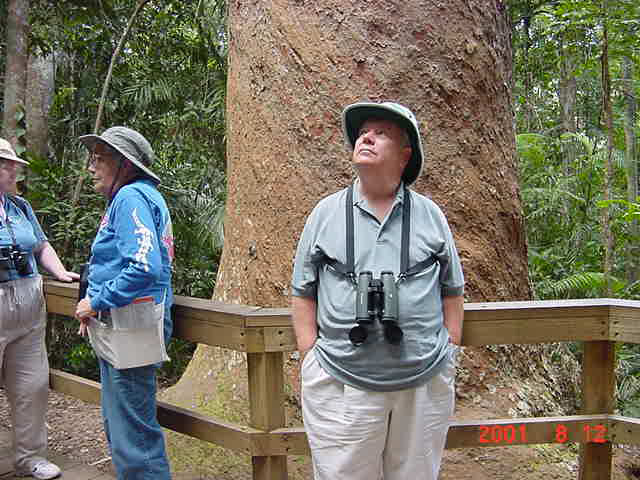
Mary Anne, Flora and Bert on a boardwalk in the forest |
We hiked with Richard a mile or so down through the woods to a
clearing where the staff had prepared a wonderful breakfast of
English porridge, sausage and eggs cooked over an open fire.
Freshly squeezed orange juice, too. The morning was
wonderful—cool and sunny. On the way down we all got
incredible views of the brilliant Australian King Parrot. This
is a
large slender bird with a red body and green wings. We also
saw Spotted Pardolote and Yellow-throated Scrubwren. Leila’s
and Beula’s legs were giving them problems so the cook, Barry,
gave them a ride back to the lodge. Carol was
bold enough to try the zip line that the staff had set up in
the clearing. The rest of us went birding at the edge of the
forest. We finally found a Logrunner scratching in the
leaves—very difficult to see as it moved in and out of the
shadowy undergrowth. Richard yelled out, “Topknot” and pointed
up to the tops of the trees. His eagle eyes had seen the rare
Topknot Pigeon streak across the sky and land in a tree. It was well hidden
and only visible from certain angles so only a few of us got
to see this bird with the unusually flaring head. We also
heard the very strange call of the Wompoo Fruit Dove.
After a brief break in our rooms, a number of us went with
Richard down another trail. Here we found one of the real
treats of the trip, a male Paradise Riflebird—with gorgeously
subtle iridescent colors. It was basically black until it
moved into the sun revealing a green head, blue tail and
purple chest. It was actively searching under the bark of a
tree.
After another hearty lunch, we all voted to rest for a couple
of hours. We had been going pretty hard the past couple of
days. But at 4:00, we were out again searching another trail.
Some of us found a Bassian Thrush near one of the sheds near
the lodge—this is a large robin-like thrush that has scalloped
feathering on its chest. We heard many catbirds mewing their
hearts out.
After dinner we went over our lists and discovered that, as a
group, we had so far on the trip seen 199 birds. And we still
had the second half of our adventure to go! Of course, we
realized that it will become more and more difficult to add
species as the trip goes on.
The following morning one of the frogmouths was on the same
branch it was on yesterday. After a hearty breakfast (I stuck
with oatmeal and fruit, I’m proud to say), we had one last try
at some of the endemics that are only found here (e.g., the
Regent Bowerbird). No luck with them but a Logrunner ran right
across the trail in front of me and most of us had our best
looks ever at this secretive bird. A few reported seeing a
Noisy Pitta. Roz had rejoined us with our familiar brown bus.
We packed the trailer, got it unstuck from a rock and bade
farewell to Binna Burra Lodge, a place we would gladly have
spent another week exploring. From here it would be down to
lower elevations, new habitats and new birds of the Australian
coastal areas.
|
|
|
|
1. Cairns |
2. Carns & Atherton Tablelands |
3.Mareeba Kingfisher Park &
the Diantree River |
| 4. Binna Burra Lodge &
Lammington NP | 5. Iluka & Oakhampton |
6. Kiama & the South Coast | |
|
|
|
Part 5: Iluka
& Oakhampton
This is the fifth part of the birding adventure 15 Utah
County Birders experienced in eastern Australia during two
weeks of August, 2001. In this part we move into the state of
New South Wales and bird the coastal area of Iluka and then
inland to Oakhampton—close to the “outback.”
Iluka
Leaving Lammington National Park we descended through the
forests into the lowlands and headed south. We crossed from
the state of Queensland into New South Wales. Pausing to
stretch at a picnic area, Richard heard the distinctive call
of the much sought after Rose Robin. We all searched the trees
but came up empty. We did, however, see an exuberantly singing
White-throated Gerygone at the top of a tree. We stopped in
Chillingham at a highway stand to sample Richard’s favorite
treats: Sapote Ice Cream and Chocolate/Nut Covered Frozen
Bananas. They sold all sorts of unusual (for us) fruits and
vegetables, e.g., “Buddha’s Hand” (a citrus), a starfruit,
custard apples and pomellos. In one town we glimpsed a huge
plastic
prawn, perhaps 30-40 feet long, on top of a building. We
finally arrived in Iluka, a retirement community on the
estuary of the Clarence River. We began to see Galahs (large
and common pink, gray, white parrots), colorful Eastern Rosellas, Crested Pigeons and
Pied Butcherbirds. Australia has
some of the most colorful “common” birds in the world. We
checked into pre-fab trailer cabins in the Anchorage Tourist
Park. Each pair of us has large rooms with lots of beds.
Ivan’s bedroom has four bunks to choose from and I get a
double bed. We even have a spacious kitchen and living room.
Before it got dark, Richard took us out birding near our park.
We could hear but not see Striped Honeyeater. We did see quite
a few Variegated Fairy-Wrens, a few striking Red-backed
Fairy-Wrens, and some managed to see
a Crested Shrike-Tit. There are lots of Whistling Kites around
us since we are so close to the estuary. After dinner at the
local golf club, we went spotlighting. Nothing of note except
for another Tawny Frogmouth.
At 6:00 am Richard took
us birding behind our park and managed to scare up a
difficult-to-see Tawny Grassbird. It generally stays hidden in
deep grass. We also found more Red-backed and Variegated
Fairy-Wrens, another Crested Shrike-Tit, Satin Bowerbird, Pied
Butcherbird, and many other more common birds.
|
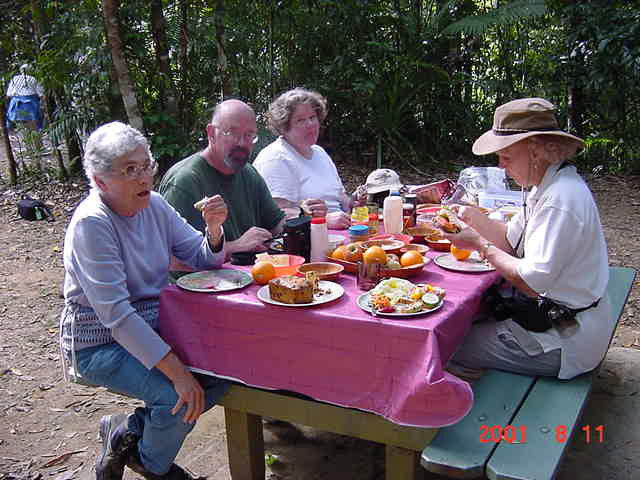
We ate well the whole time on real plates and silverware
(when needed). |
After a great breakfast, we headed down to the Iluka Nature
Preserve, a littoral rain forest. “Littoral” means right next
to the ocean (or a lake). Through our scopes we found
Australian Gannets soaring over the waves and diving into the
sea. In the tide pools we found Whimbrel, Ruddy Turnstone, and
Red-necked Stint. As we started our walk through the forest,
we found
several Little Wattlebirds (another honeyeater) eating figs
and saw many Figbirds. Lewin’s Honeyeater would become one of
our most common birds the rest of the trip. Other common birds
of the forest were Eastern Whipbird, Golden Whistler,
Large-billed Scrubwren, and Eastern Yellow Robin.
We held a brief church service in our spacious cabin while Roz
and Richard prepared us lunch. The afternoon was spent looking
for water birds on the ferry from Iluka across the estuary to
Yambo and back again. We saw a soaring White-bellied Sea-Eagle
and spotted a Peregrine Falcon and an Osprey. On shore, we got
to compare all four Australian cormorants: Pied, Little Pied, Little Black and Great. On a sand bar was
saw Pied Oystercatcher, Bar-tailed Godwit, Crested Tern, and
other common shorebirds. We all enjoyed an ice cream sandwich
at the ferry station.
Richard had seen Regent Bowerbirds here in the past. So we
were very excited to have what we thought was one in our scope
behind our trailer park. Alas, it turned out to be the more
common Satin Bowerbird with a patch of sunshine on it. We did
get great looks at White-cheeked Honeyeater and glimpses of
Tawny Grassbird. At the end of the day, we relaxed to one of
Roz’s best dinners: curried chicken, steamed cabbage and
cauliflower with potatoes. Tasty!
|
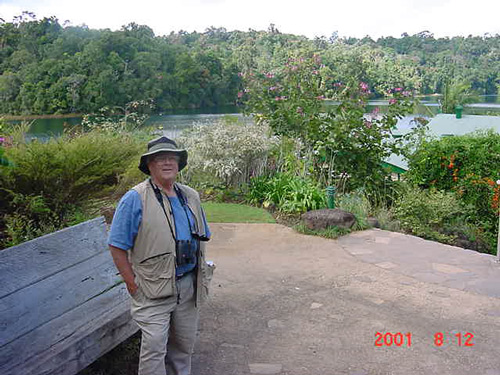
Ivan Call - ready for the birds.. |
Knowing we were leaving Iluka after breakfast, some of us did
not want to give up on birds we hadn’t seen at all or hadn’t
seen well. Ivan and I were up at first light but found that
several others, Milt, Alton, Junece and Carol, had the same
idea. We all tromped around in the wet, tall grasses until we
got a decent look at Tawny Grassbird and Red-backed
Fairy-Wren. As
we walked back to the park, we scared up a covey of Brown
Quail from a burned patch in the field. Checking out the
shrubbery around the park office, Ivan spotted some birds
feeding on the hibiscus plants. They turned out to be Striped
Honeyeaters, target birds for this stop. We quickly ran to get
everyone to come and take a look. After a hasty breakfast, we
loaded up the bus and headed out. Just a short distance away,
Richard hollered, “Emu, emu!” He slammed on the brakes and we
looked out to see a very tall, ostrich-like bird sauntering
along the golf course in the early morning sunlight. Richard
said it was a juvenile but definitely a wild bird. It turned
out to be the only Emu we would see on our Emu Tours
trip—would
Richard really have refunded our money if he couldn’t show us
an Emu? Did it birdie hole seven?
We spent much of the day traveling inland to a totally
different habitat. We passed through Grafton, Glen Innes and
Armidale.
|
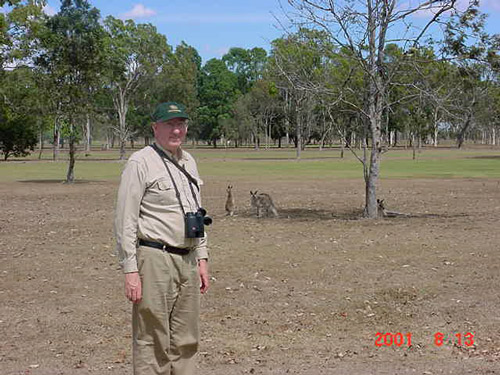
Ned Hill at the Golf Course (aka. "Kangaroo Park") |
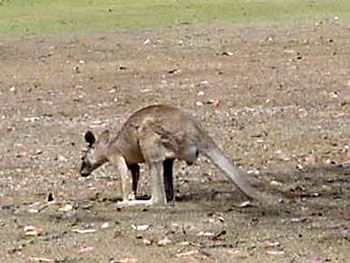 |
Stopping at Dangar’s Lagoon we saw Bluebill, a
relative of our Ruddy Duck, and Hoary-headed Grebe. Also new
for the trip was Musk Duck, a duck with a strange-looking
leathery flap hanging down from the male’s bill. We found our
first Australian Ravens whose voices sound like small children
crying. Near Manilla we found a flock of Sulphur-crested
Cockatoos with some Little Corellas mixed in. The Cockatoos
would become quite common further south. The terrain became
much more open and dry after we crossed the Great Divide Range
(about 3,500 ft.). Kangaroos became more common. As the light
faded, Richard had one of us ride “shotgun” to help him watch
for kangaroos. They can do quite a number on a car or bus and
they’re much faster than cows! We finally arrived at our
destination, Oakhampton Station (a “station” is a ranch)
operated by
John and Belinda Nixon. John’s family homesteaded here in
1847. We shared with John the significance of that year to
Utahns—the year the Mormon pioneers came into the Salt Lake
Valley. We stayed in “shearer’s quarters” where the shearers
used to stay when they came through to shear the sheep. Being
at a much higher elevation than we were in previous stops, the
air turned quite cold after sunset. Our quarters had only one
light and were quite rustic. The bathroom was in the next
building. An electric heater kept us warm. In the lovely old
mansion house we ate a sumptuous meal of lamb, chicken, salmon
mousse and lots of vegetables. The home was originally built
in the 1880’s but added to the 1930’s. It is now used
basically as a “dude
ranch.” However, they lease out the fields for grazing sheep.
The next morning proved to be very exciting for finding new
birds. As we stepped out the door Red-rumped Parrots flew into
the yard, perched on the wires, and then fed on the frosty
ground. The very common “Willie Wagtail” we found in a bush
and almost skipped over without a glance turned out to
be—thanks to Milton’s sharp eyes—a Restless Flycatcher. In the
top of
the same tree were Little Lorikeets and then some White-plumed
Honeyeaters flew in. In another tree we found dozens of
colorful little Zebra Finches. Five lifers in about five
minutes.
Local birders Russ and Jenny Watts joined us. They accompanied
us to the Borah Reserve, an open forest with dry grass
underneath. We found Brown Treecreeper and then a plain brown
little “robin” named Jackie Winter. We heard Rufous Songlark
but didn’’t get to see one for a few stops. One great find was
the Turquoise Parrot, a subtly colored but shy bird of the
open forest. Then we found the striking, black-and-white
Hooded Robin and saw a Little Eagle soaring overhead. The
latter finally landed in a tree where got good looks at it
through the scope. We found yet another honeyeater, this time
Spiny-cheeked Honeyeater. Common Bronzwings darted across the
road (they are doves).
Our real target bird for this area is the Regent Honeyeater.
They are endangered and feed primarily on the flowers of the
Iron Bark Tree. Since this tree has been almost logged out of
existence for fenceposts, the honeyeater is nearly gone, too,
with an estimated population of only about 1,000. The Watts
have worked hard to preserve this Iron Bark habitat. The birds
are returning from migration right at this time. Five were
reported in this area last week but, try as we might, we could
not hear or see one. The “almosts” turned out to be Fuscous
Honeyeaters. At our last stop for the Regent, we found a very
small Weebill building a nest. This little guy is only about 9
cm—hummingbird size. As we were driving back to the station,
Richard spotted some Yellow-rumped Thornbills in the field. As
we got out for a look, a few of us got to see Speckled Warbler
and hear its
distinctive song. I think I had 18 lifers today.
After trying out the showers—a bit cold before and after—we
had a delicious spaghetti dinner followed by Jenny’s plum
pudding (all requested her recipe). Tomorrow we have a long
drive ahead of us as we travel down the coast to Sydney and
points south.
|
|
|
|
1. Cairns |
2. Carns & Atherton Tablelands |
3.Mareeba Kingfisher Park &
the Diantree River |
| 4. Binna Burra Lodge &
Lammington NP | 5. Iluka & Oakhampton |
6. Kiama & the South Coast | |
|
|
|
Part 6: Kiama
and the South Coast
This is the sixth and final part of the birding adventure
15 Utah County Birders experienced in eastern Australia during
two weeks of August, 2001. In this part we head south through
Sydney and conclude our adventure by exploring the coastal and
inland areas around Kiama.
South through Sydney
|
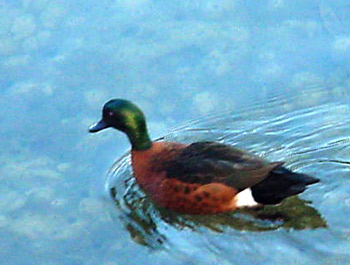
Chestnut Teal |
We awoke to a cold morning in the shearers’ quarters of
Southampton Station, a sheep ranch in the Australian “outback”
or at least as close as we would come to it. The proprietor,
John Nixon, had built a roaring fire in the common room
fireplace. Although there was frost on the grass, John told us
he had seen only about two snowfalls in his seventy years
here. We ate
a hearty breakfast and loaded our luggage into the trailer.
The day was spent driving over rural roads to the coast and
then down the freeway towards Sydney—all through lush green,
rolling countryside. Well-kept farms dotted the land
interrupted by eucalypt forest and fingers of ocean that
penetrated inland at various places. Wind and rain showers
punctuated the day. So
far we have been fortunate in that our birding days have been
perfect. We stopped a few times to stretch and have lunch but
the birding was difficult in the wind. At one park we found
one new bird, a Red Wattlebird—a common resident of the
southern coasts and another of the honeyeater family.
|
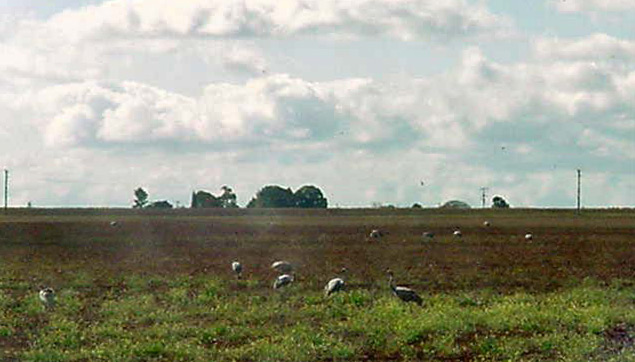
Open farmland |
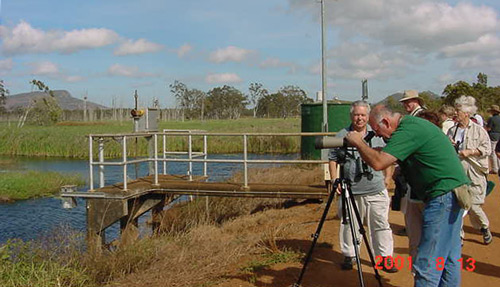
Stopping along the way |
By mid-afternoon we crossed the famous Harbor Bridge into
downtown Sydney, catching a glimpse of the remarkable Sydney
Opera House. We learned there were no freeways leading around
Sydney—the road traveler must go through on slow city streets.
In a rare deviation from Richard’s usual custom, we stopped at
a McDonalds for a snack. We arrived in Kiama, near the
industrial city of Wollongong about two hours south of Sydney.
All of us were amazed at Richard’s skill in backing the bus
and loaded trailer from the busy street down into the narrow
driveway next to the apartment complex. We checked into
some very nice apartments where, for the first time, we had TV
and could watch CNN and catch up on the outside world.
Kiama, Bomaderry Creek, Bass Point
and Windang Beach
The forecasted rain did not materialize but the wind was still
strong. We decided to do our mainly coastal birding today and
hold our forest birding tomorrow with its lessening chance of
wind. We stopped briefly at the bay around which Kiama is
situated. We saw some Australian Gannets over the water
and then spotted a Hump-backed Whale just
a few hundred yards out. As we got the scope on the huge
animal, we saw a second, smaller spout—a calf became visible
by the side of the larger whale. What an unexpected treat!
We drove down to Bomaderry Creek State Park, a top birding
spot on the south coast. Just from the parking lot we found
several honeyeaters before breakfast: Yellow-tufted, White-naped,
and Yellow-faced were almost abundant—all very
strikingly beautiful. Some saw Red Wattlebird for
the first time. Roz had prepared a full English breakfast for
us after our
initial birding. We then went to search for the specialty of
the area—the only endemic of New South Wales: Rock Warbler,
a small brown and rust-colored bird that nests in the rock
walls. Some of our group remained on some benches above the
canyon while the rest of us followed Roz and Richard down into
the shaded gorge. We thought we heard the bird several
times but could not find one. We managed to see a number of
birds we had seen before but not the target. Of course, as
often happens in the birding world, the outcome was
unexpected: Those who rested on top saw at least four of the
warblers much to the consternation of those who huffed and
puffed their ways into and out of the canyon.
We then went to Bass Point Reserve, a point of land that
sticks out into the ocean. Along the rocky shore, we found
Eastern Reef Heron and Sooty Oystercatcher. We also spotted
shearwaters flying low over the waves. We could see some white
and black on them—Richard said they were likely Fluttering
Shearwater. As we ate lunch, Superb and Variegated
Fairy-Wrens were common in the grass around us. They have
become our favorite little jewels. A Red-whiskered
Bulbul sang from a bush near the picnic area—the same
species that was successfully introduced into Florida.
At Windang Beach Richard spotted a Double-banded Plover,
a migrant that winters here away from its nesting grounds in
New Zealand. The beach also held Kelp Gull, Red-capped
Plover, Black Swan, and White-necked Heron among
the usual cormorants and shorebirds. The tall grasses near the
beach usually harbor Golden Cisticolas, small sparrow-like
birds, but the high winds kept them low and out of sight.
After a great dinner at Silo’s, we turned in, looking forward
to our final day of birding in Australia.
Jamberoo, Barren Grounds, and
Budderoo NP
We were sorry to leave these very nice and comfortable
apartments. But we had planned some exciting birding for our
final full day of our great adventure. The day was perfect—no
wind or rain. We drove up to Richard’s home on Misty Lane in
the woods above Jamberoo—a small town in the hills west of the
coast. Claralyn and I had stayed here with Richard for three
days of birding in 2000. That was where the idea for this
excursion was hatched. Large trees and an abundance of birds
surround the yard: Bassian Thrush, Pied Currawong, Crimson
Rosella, Rainbow Lorikeet, Eastern Whipbird, Brown Cuckoo-Dove,
and many more.
After breakfast, we drove a few miles up to the Barren Grounds
Reserve, a large wooded and grassy area created by Richard
over a period of eight years for the Australian government.
The tracks (trails) through the area often produce the rare
Eastern Bristlebird but we failed to even hear one—the first
time Richard ever struck out on that species on this track. We
did see a striking Beautiful Firetail, many New-Holland
Honeyeaters and got glimpses of Southern
Emu-Wren.
We drove to the bordering Budderoo National Park. In the low
grasses, Southern Emu-Wren were easier for the group to
see. We formed a long line across a tall grass field and
started walking from one end to the other. Suddenly a greenish
parrot was flushed and flew low with frantic wing beats off to
the side. It was difficult to find the Ground
Parrot. Most parrots, of course, are tree-dwellers. This
one spends most of its life hiding in thick grassy areas. Its
close cousin, the Night Parrot, is thought to be extinct. The
body of one was found a few years ago in Queensland so Richard
and other birders have spent many nights trying to find a live
one—no success. After the excitement of finding the Ground
Parrot, Richard spotted
a beautiful Scarlet Robin for us, one of the most
desired birds of the trip. We got to see a male in full
breeding plumage. We stopped at Carrington Falls—and we
thought we had a Rock Warbler on the rocks below. It turned
out to be a White-browed Scrub-Wren, a
more common bird.
Stopping back at the Barren Grounds headquarters, we purchased
some CDs of Australian birds and other momentos of our trip.
Outside, we heard a Pilotbird but did not manage to get it to
come out in the open for us to see.
Minnamurra Rainforest
|
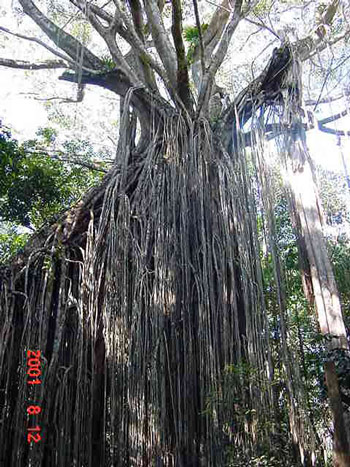
"Gigantic Strangler Fig" |
After lunch back at Richard’s we drove a short distance to the
Minnamurra Rainforest. The walk through the main trail went
along a creek surrounded by huge trees including gigantic
Strangler Fig. In the creek we found several Waterdragons.
After much searching, we finally spotted our target, the Superb
Lyrebird—a very unusual bird that can mimic the song of
almost
any other bird of the forest. Some people even claim it mimics
songs of man-made things but these assertions may be
exaggerated. The bird was scratching around in the leaves and
let us get very close. Yellow-throated Scrub-Wrens were
following closely benefiting from the insects scared up by the
Lyrebird. We also heard the characteristic call of the Wonga
Pigeon but failed to see one. As we were gathering to
board the bus, four more Lyrebirds were just off the parking
lot—amazing to see them so close and unafraid. Richard heard
the call of a Rose Robin again but we searched in vain.
Homeward Bound
We bade farewell to Roz—our talented cook, driver, fellow
birder and new-found friend. Richard drove us into the heart
of Sydney where we checked into a hotel for the last night of
our great adventure. Richard and Roz had worked very hard to
make our trip a success. They had attended to our every need
during these two weeks. The flight back to the US the next
morning was strange indeed—we actually arrived in San
Francisco (after a 15-hour flight) a couple of hours before we
left Sydney. Of course, the International Dateline helped with
that magic. We had seen 260 birds—most of them lifers for
those who had not been in Australia before. And we had visited
some of the most beautiful parts of that great country. We had
become better friends with each other and had taken away
memories that will linger in our minds for decades to come.
|
|
|
|
1. Cairns |
2. Carns & Atherton Tablelands |
3.Mareeba Kingfisher Park &
the Diantree River |
| 4. Binna Burra Lodge &
Lammington NP | 5. Iluka & Oakhampton |
6. Kiama & the South Coast | |
|
|
|
Remembering:
Ivan Call, Sylvia Cundick, Ed and Beula
Hinckley and Donna Thorum
|
|
|
|
